Finalists announced for purmundus challenge 2021
October 7, 2021
The purmundus challenge organiser, cirp GmbH, has announced the thirty-five finalists of this year’s competition, which focuses on the theme of ‘Innovation in progress’. The challenge winners will be presented with their awards on November 18 at Formnext 2021, which will take place in Frankfurt, Germany, November 16–19.
Commenting on the 2021 challenge, the organiser stated, “This year’s finalists show the enormous potential of Additive Manufacturing. 3D and 4D printing are more than ever and increasingly around the world a core manufacturing process paving the way for end-to-end digital and consistent process chains in various different markets. In particular, scaling is emerging as a new trend. The 2021 purmundus challenge shines a spotlight on forward-looking end-to-end solutions from twelve countries on five continents under the motto ‘Innovation in progress’.”
The finalists in this year’ competition are said to show forward-looking concepts in the fields of medicine, biotechnology, 4D printing, VR, robotics, e-mobility, powertrain technology, mechanical and plant engineering. In addition to a concrete shading of buildings, a lift, a juice squeezer made from lemon peel, a kinematic chair and prostheses for dogs, the finalists include products from the sports fields of ballet, golf, climbing and artistry. Design products from the music and leisure sectors are also included among the finalists. A smart gear, a newly developed material switching unit for FDM, potential applications for scaling processes and agile systems, and a vision for managing AM part production on a global scale are also presented.
The panel will judge the entries in terms of use, economy and aesthetics as well as the design itself and the innovation. The awards are worth a total of €30,000. In addition to the first three places, the purmundus challenge will also feature awards in the categories of Special Mention, Simulation-Driven Design, an Innovation Prize and a Newcomer Prize. A Public Choice Award will also be included.
Metal Additive Manufacturing finalists in the Purmundus Challenge 2021
Waldwiesel.E – The Gravel E-Bike, by Urwahn Engineering GmbH, Sebastian Meinecke and Silke Walter
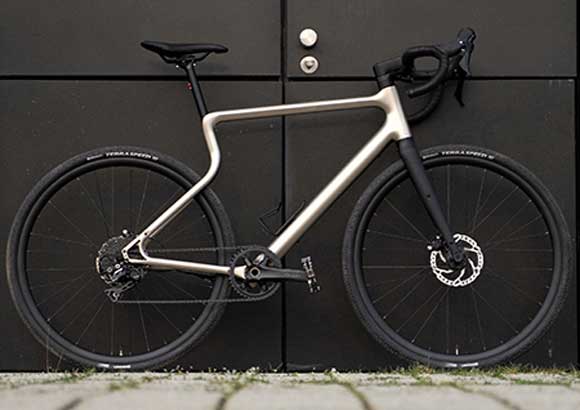
Urwahn Engineering GmbH states that the Waldwiesel.E is the first gravel e-bike that it mass-produced using metal Additive Manufacturing. It was designed to create a balance of form, function, lightweight construction and material. The steel frame is said to rival conventional aluminium frames in weight and is inspired by the appearance of modern carbon frames.
AM allowed the creators to develop a steel frame design that has reportedly never been seen before: the special rear-end suspends the rear wheel elastically and allows increased riding comfort, as any bumps and irregularities can be compensated for. Accompanied by the targeted optimisation of the additively manufactured components, the system weight could also be significantly reduced.
Aesthetically, the steel frame of the Waldwiesel is said to be more reminiscent of high-end monocoque frames. It also features a number of technical integrations, such as a GPS tracker, LED light units and a powerful electric drive. The precise electric drive adapts to the rider’s riding style and has a powerful 40 Nm of torque at the rear wheel. The battery has a range of up to 80 km is discreetly integrated into the down tube. The Waldwiesel.E is navigated digitally via an app while emerging dangers are brought directly into view via the LED headlights.
In designing the Urwahn Gravel e-bike, we were keen to take the Waldwiesel.E to a new level by merging novel technologies with thoughtful design and breaking with tried-and-true structures. Essential for the reinterpretation of the frame structure was the demand for a balanced relationship between form and function, resulting in an aesthetic and user-friendly overall appearance.
Smart Gear, by Fraunhofer IGCV, Veronika Stapff and Maximilian Binder
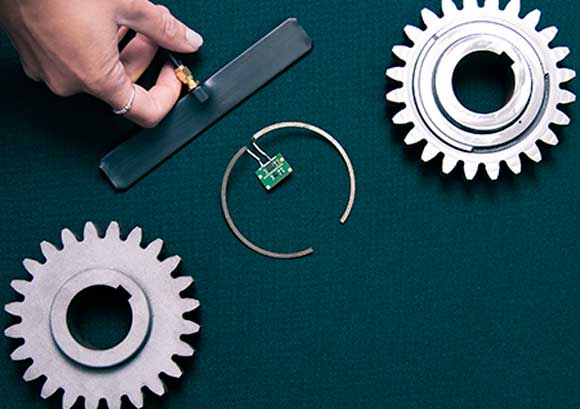
The Smart Gear is a multifunctional component with an additional passive, battery-free sensor system and additively printed RFID antenna. The mechanical benefit of the power transmission of a gear is supplemented by sensor technology and a structurally integrated antenna. The integrated RFID accelerometer is able to generate sensor data inside without batteries (passively, without additional energy supply) and send wirelessly via the RFID frequency UHF (868 MHz) to an external receiver. The data can be recorded by means of a reader at a distance of approximately 10 mm. Measured values are relevant for examining gearwheel/gearbox faults and for observing gearwheel behaviour.
The integration of RFID-sensor technology aims to solve challenges in the integration of electronics in the component, such as data transmission from a rotating component. Additive Manufacturing makes it possible to integrate and use passive sensor technology inside the gear. In order to transmit signals in the required energy range despite the impermeability of case-hardened steel to frequency bands, an antenna was designed from the same material (20MnCr5) and optimised in its geometry dependent transmission and receiving properties.
The antenna is additively manufactured together with the gear, is electrically isolated on the front side of the gear and is conductively connected to the sensor system inside the gear. By designing a curved antenna shape, the data from the eccentrically rotating sensor system can be acquired with a statically positioned reader. To ensure that the manufacturing process can be carried out within a single building process, support structures are built from solid material. The cavities are then filled with insulating material, thus the antenna and the sensor system are mounted in a fixed position and the support structures can be removed.
The Smart Gear also offers potential added value in the development of wireless data transmission to the interior of dynamic metal components. The invention also overcame the challenge of shielding properties of metal. AM enables access to the interior of the component during the manufacturing process and the simultaneous production of several components within one construction process.
Highly Functional Integrated 3D Printed Brake Caliper, by ETH Zürich – Product Development Group Zurich, et al
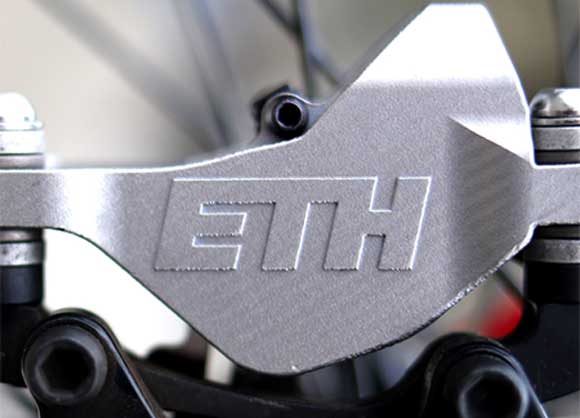
Designed as part of a student project by the Product Development Group at ETH Zürich, the highly integrated bike brake caliper was produced using metal Additive Manufacturing to demonstrate the free functional complexity potential of AM with three added values: design freedom for internal fluid channels, the functional integration of both, a monolithic compliant membrane and topology optimised lightweight design.
Traditional brake calipers are hydraulically actuated using pistons and consist of two halves that are held together by screws. Unfortunately, the design is prone to leaking, and the assembly and bleeding can be time-consuming. The team managed to reduce the number of parts from eleven to one by replacing the pistons with a compliant mechanism: a thin corrugated membrane.
This monolithic design allows the caliper to be additively manufactured as one single part with all functionalities integrated. The fluid channels were optimised to trap less air while bleeding. The design is scalable and could reportedly be applied to cars or aerospace as well. The -35% lightweight design is hoped to reduce fuel consumption and CO2 emissions in such an application domain.
Flexified, by ZHAW/Zentrum für Produkt und Prozessentwicklung, et al
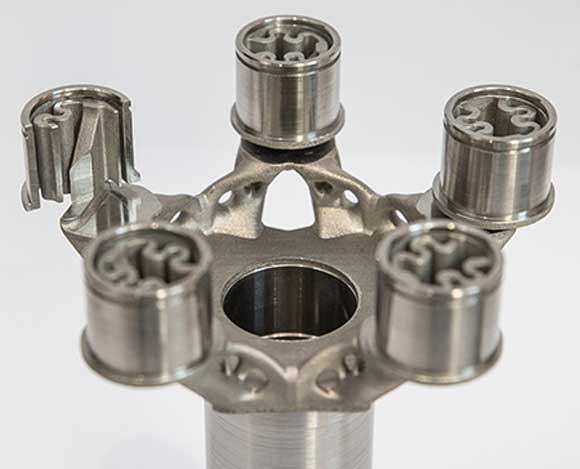
This project shows how interdisciplinary use of hybrid Additive Manufacturing and topology optimisation lead to better load distribution and thus to a significant increase in power density in planetary gears.
Planetary gears are used wherever speed and torque need to be efficiently translated. The circular arrangement of the planetary gears and the ring gear around the sun gear enables a compact and lightweight design. Lightweight planetary gears are used in a wide range of applications in mechanical engineering, automotive, aerospace and aviation.
However, due to manufacturing variations – as well as different bearing clearances – all planet gears are never loaded equally. In addition, the deformation of the planet carrier or planet pin means that the load is not evenly distributed along the tooth flank. These effects are taken into account in the design of planetary gear units by means of corresponding load factors.
With a flexible design for the planetary pin, the load distribution can be improved and the load factors can be reduced. However, the design is complex and requires a great deal of expertise in design, manufacturing and assembly.
The redesigned planet carrier combines twenty-seven components in one, simplifies the design, manufacturing and assembly. The actual planet carrier was optimised in terms of stiffness, weight (-61.7%) and inertia (-74%) through topology optimisation. The flexible planetary bolts for holding the planetary gears are fixed to the carrier. Their complex press-fit connections for mounting in the carrier are no longer necessary. The compliant elements compensate for manufacturing inaccuracies and thus enable a higher power density in the gear unit.
The planet carrier was designed as a hybrid component. The complex part, the actual planet carrier with the flexpins, was additively assembled on the shaft stub, which was said to be easy to manufacture. Subsequently, the final machining was carried out on a turning-milling centre.
The design was developed as part of a bachelor thesis by Philip Dreher and Colin Gubler.
Elevate, by MX3D, Schindler Group, et al
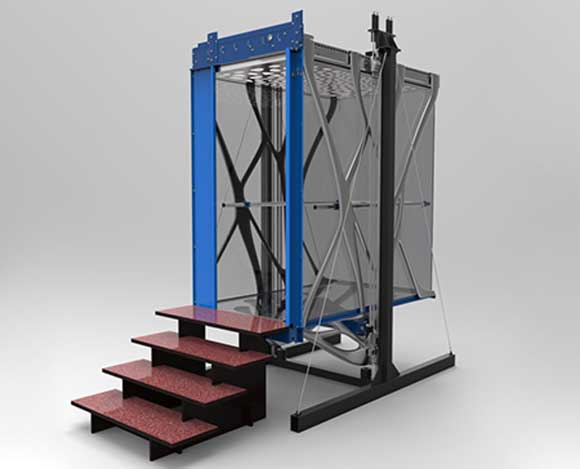
Schindler and MX3D conducted an in-depth study into the potential of using topology optimisation to redesign elevator carts. MX3D’s robotic Wire Arc Additive Manufacturing (WAAM) technology, a wire-based Directed Energy Deposition (DED) process, is said to have perfectly fit the geometry freeform and size requirements needed to achieve these optimised design results for the metal additively manufactured ‘Elevate’ cart.
The collaboration focused on exploration and inspiration. Topology optimisation can lead to significant weight reduction, and, when combined with robotic metal AM, a new manufacturing method emerges that offers shorter innovation cycles and in-house production of customised solutions.
The project was said to have been made possible due to MX3D’s extensive research on aluminium Additive Manufacturing for large-scale objects. Using the right build parameters, several aluminium alloys have excellent additively manufactured mechanical properties. Here, the alloy AlMg 4.5 Mn was chosen for its exceptionally strong material properties.
Cobra Golf KING SuperSport-35 Putter, by Cobra Golf, Parmatech, HP Inc, et al
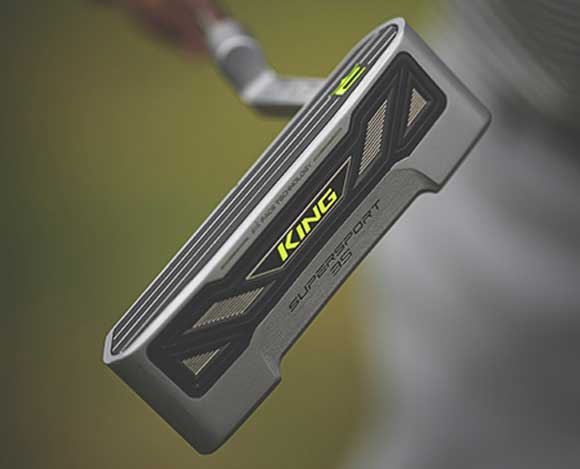
Golf club manufacturer Cobra Golf developed the KING Supersport-35 putter using Additive Manufacturing, and in collaboration with Cobra engineers and the teams at HP and Parmatech. The entire putter body is additively manufactured printed using 316 stainless steel, and then sintered at a high temperature to bind the metal and form the final head part.
With the capabilities of HP’s Metal Jet Binder Jetting (BJT) technology, engineers were able to additively manufacture an intricate lattice structure within the body. This lattice reputedly fine tunes the feel and optimises the distribution of weight within the putter head to create the highest moment of inertia (MOI) without the need for additional fixed weights. During the final step of the manufacturing process, the surfaces of the putter are precision milled using a Computer Numeric Controlled (CNC) machine to ensure precise shaping and detail while adding the finishing cosmetic touches.
The Supersport features a high MOI heel-toe weighted design for maximum stability, and a plumber neck hosel with a 35° toe hang suitable for slight-arc putting strokes. In addition to the additively manufactured design, the KING Supersport-35 Putter features a face insert designed in partnership with SIK Golf, which utilises its patented Descending Loft Technology (DLT) in an effort to create the most consistent and accurate roll on every putt.
Toucan Beak, by Aidro – Desktop Metal Company and Tommaso Tirelli
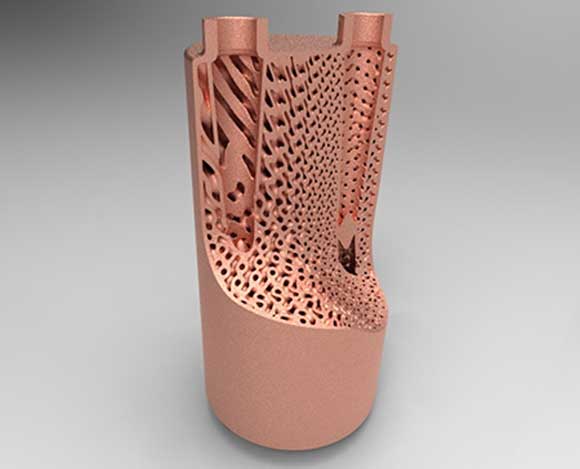
The Toucan Beak is a heat exchanger (HE) with metal additively manufactured microchannel structures, designed through multidisciplinary topological optimisation and machine learning simulation (AI), and enabled by high-performance computers.
The bio-inspiration of the Toucan Beak is lightweight but stiff, thanks to controlled and variable porosity, and integrates multiple functions, including a controllable vascular heat exchanger.
The outcome is an efficient, low-weight, low-carbon-footprint HX solution, created through an advanced design process. Digital inventory and distributed manufacturing readiness through AM. Increase energy efficiency for existing systems without system layout changes or for spare parts.
The goal is to improve heat exchange, reduce pressure drops, reduce weight and space, on a Laser Beam Powder Bed Fusion (PBF-LB) solution. The PBF-LB process allows the manufacture of micro-channel complex structures. Readiness for digital inventory and distributed manufacturing (i.e. in proximity to the end-user site with extremely short lead time) and enables the integration of multiple functions in a single part.
Automotive Bracket using agile development process, by EDAG Engineering GmbH, et al
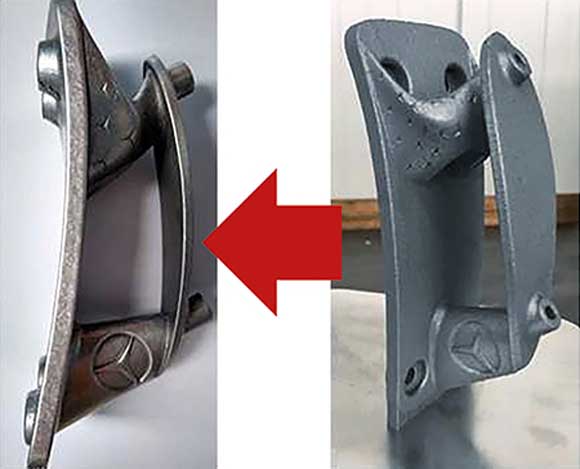
This additively manufactured EDAG bracket for a rear spoiler combines an aesthetic design and various customisation options with an ecologically sustainable production process due to its support-free design. The company found that using principles of agile working and Scrum software, the development process of additively manufactured components experience a significant increase in efficiency. The direct involvement of the production partner can lead to early – and continuous – improvement of the maturity level of the product.
The approach of having the current development status manufactured after each individual sprint allows the team to immediately investigate and experience the quality of the product. It also allows optimisation potential to be recognised and taken advantage of. That way, potential issues in the manufacturing process can be resolved at an early stage, compared to late and expensive changes in the conventional development process. The result is an accelerated, joint and efficient development process for additively manufactured components in which the project participants of the READDI research project, funded by the BMBF, were also involved from the beginning.
In a variant of this approach, the efficiency and variability of the design process can be further improved by the use of innovative software tools. The component is not designed conventionally but with this approach, a ‘component DNA’ is generated with the help of a visual programming language. This ‘DNA’ controls the parametric geometry creation, taking into account the respective boundary conditions and requirements for the respective component.
Future of electric motors with AM, The Manufacturing Technology Centre and Miguel Fernandez
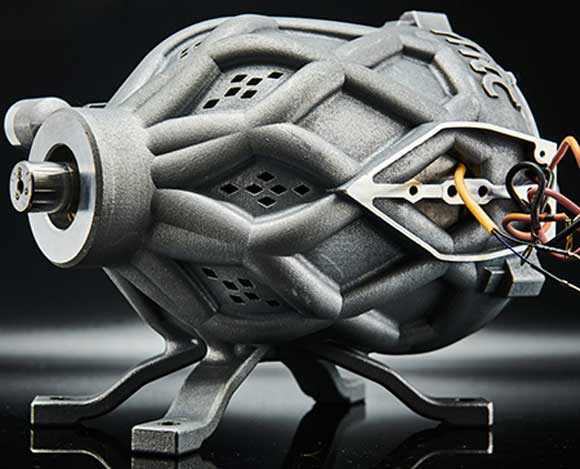
AM has been identified as an enabling manufacturing technology to produce power-dense electric motors in a repeatable and short lead time. Whilst AM isn’t new, its application for end-use parts and tooling has become more prevalent only in recent years, and is demonstrating its potential to change the way that products are designed and manufactured.
In academia, there are a growing number of research papers that highlight the benefits associated with an additively manufactured motor, but there are limited examples of AM in commercially developed products. The UK-based Manufacturing Technology Centre (MTC)’s technology experts initiated a project that considered the wider implications of AM for electric motors. The aim was to provide recommendations, based on existing limitations, for creating the next generation of electric machines.
With support from the National Centre of Additive Manufacturing (NCAM) and the MTC’s Electrification Steering Committee, the project team were able to identify the key challenges being faced by conventionally manufactured motors. Technology Readiness Level (TRL) and Manufacturing Readiness Level (MRL) assessments were conducted of AM for key motor components. These assessments were combined with learnings from past projects and an analysis of present manufacturing techniques for each component. In doing so, the MTC was able to identify the current constraints and how, by, applying AM, these limitations may be resolved.
To demonstrate the potential benefits of leveraging the capabilities of AM, the cooling method of a commercial motor was reassessed, as a result of several iterations of a liquid-cooled motor casing. The benefits that AM can provide for each component of electric motors were identified, and a research and development roadmap was created to outline a route for progressing the implementation of AM in electric motors.
Consequently, the MTC was able to propose new projects that can address the challenges and constraints of using Additive Manufacturing in electric motors. The redesign of the casing by implementing liquid cooling channels allowed the motor to produce more power without overheating, a weight saving of 10% and a size reduction of 30%.
The process of manufacturing electric motors has a number of challenges to overcome: complex or manual assembly, materials that are difficult to process and can be rare and/or expensive, thermal management and lightweighting. By leveraging the AM capabilities through the product redesign as demonstrated in the casing, key benefits were identified throughout the product and supply chain: increased motor power density, resulting in a reduction in size and mass of key components; part count reduction, leading to simplified assembly and supply chains; increased manufacturing efficiency and reduced lead times; lower running costs; waste reduction; reduced assembly and inspection costs.
















